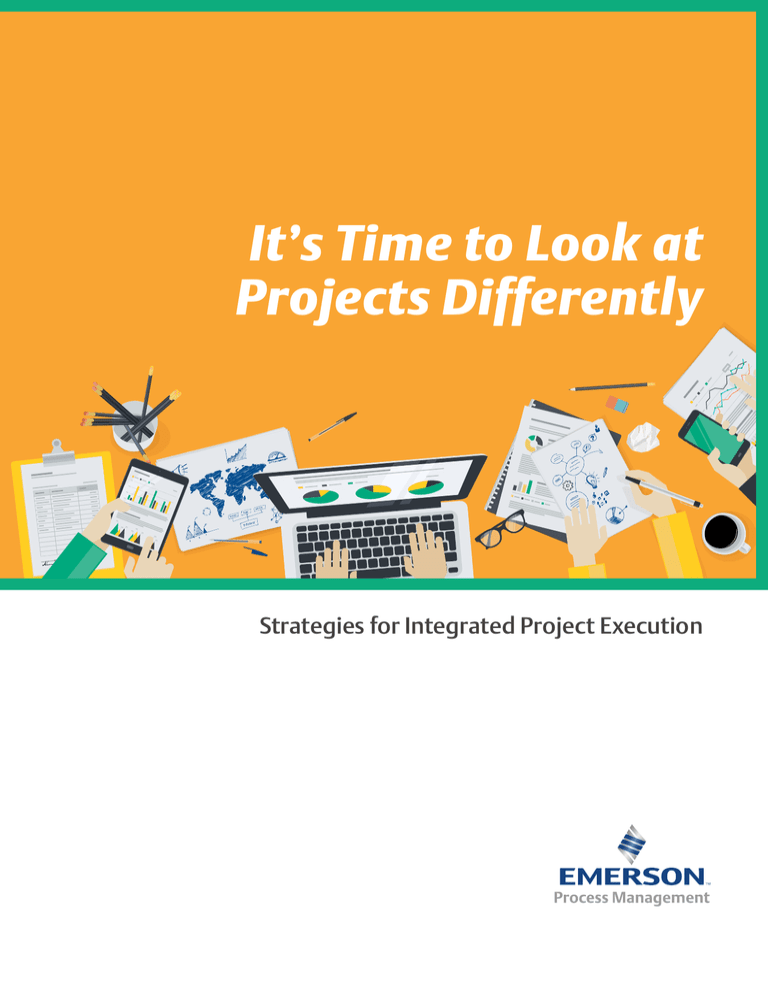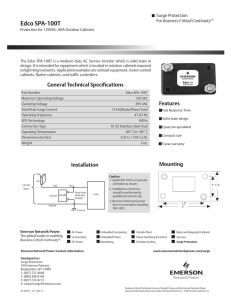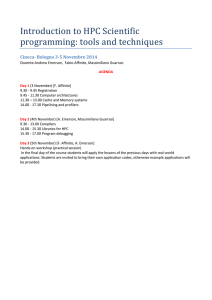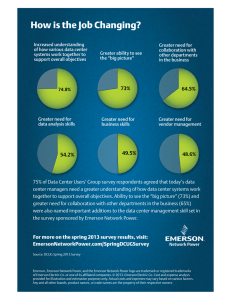
It’s Time to Look at
Projects Differently
Strategies for Integrated Project Execution
It’s Time to Look at Projects Differenty
With increasing size, growing complexity, and shorter schedules, the challenges of
executing a billion dollar project on budget and on time are becoming increasingly
challenging. But the impact of failing to meet those challenges is increasing. The
cost of overruns and lost revenue can exceed the cost of the project by tenfold. What
is new, maybe even transformational, is the way Emerson Process Management is
helping project executives meet those challenges and minimize project risk, with
innovative services and technology.
First, it’s the people. Emerson collaborates differently with its customers to develop
a one team mentality. We are deliberate in the way we construct our project teams
and how we build relationships with customers and other suppliers through early
engagement and flexible contracts. Recently, a customer described an Emerson
subject matter expert as “present and listening,” factors he cited as critical for the
project’s success. “It felt like we were on the same team rather than on separate or
even opposing sides,” the customer said. That kind of one team mentality makes it
possible to remove barriers and solve problems quickly. The customer went on to say,
“Having a consistent presence meant that Emerson really understood what we wanted
from the beginning and already had a vision for what would be needed at the end.”
Next, it’s the technology. Emerson hasn’t just evolved our project services; we’ve
transformed our methodology through the use of technology to drive project
planning and execution, too. A rigid approach that relies on knowing all the answers
up front is no longer a viable option. For example, to facilitate closer collaboration,
we’re leveraging virtualization platforms that make it easier for all parties involved to
share information, test solutions and make decisions, regardless of where they are
located globally. The efficiency and flexibility of proven technologies such as DeltaV’s
Electronic Marshalling and wireless networking have also dramatically altered the
implementation of the project at hand and those in the future by minimizing the
impact of late design changes.
Finally, it’s reducing complexity. We’ve found ways to eliminate work and streamline
start-ups. As one of our customers says, “you can’t screw it up if you don’t have to
do it”. Our human centered design, which is the cornerstone of our technology and
project execution philosophy, eliminates unnecessary work, reduces the complexity,
and embeds knowledge into our technology and services. A smooth and simpler
implementation can have the biggest impact on achieving a successful project. We
strive for no surprises as one customer shared, “Everyone expected some kind of minor
issue that would hold up our start-up. But that just didn’t happen.”
Jim Nyquist
Group Vice President
Emerson Process Management
2
Table of Contents
Simplify Project Execution
Easily accomodate late project changes with Electronic Marshalling
Increase Project Schedule Flexibility
Find money in configure-to-order cabinets and enclosures
Streamline Project Resources
Engage expertise regardless of location with the distributed engineering solution
Learn more at www.emersonprocess.com/projectcertainty
3
Simplify Project Execution
Easily accommodate late project
changes with Electronic Marshalling
At some point in every design process, projects involve one of the industry’s most burdensome tasks: engineering and managing
I/O. This can include tasks such as changing a few I/O from one type to another due to modifications in the field, or in an extreme
case, updating an I/O sub-system in a new section of the plant.
Because I/O hardware and software–bound by traditional marshalling–are so tightly integrated during design, development,
testing, and commissioning, simple I/O changes can cause major project delays.
Many of these project headaches can be eliminated with a new way of providing I/O on demand that allows you to add I/O anywhere
in the plant when and where you need it. When project scope increases, your design team has the flexibility in their control strategy
design and implementation to incorporate the new project scope without affecting the project schedule.
Keep Projects on Schedule
Through an innovative technology–Electronic Marshalling with
CHARMs–project design and implementation is simplified–
reducing the number or hours needed to make I/O changes.
Electronic Marshaling with CHARMs, part of Emerson’s DeltaV™
Distributed Control System (DCS), enables you to land field
cabling wherever you need it, regardless of signal type or
control strategies. Each terminal block has a single channel
characterization module, or CHARM, which allows any signal
type of field wiring to be terminated in any location. Field wires
are terminated on terminal strips, but the cross-wiring from the
marshalling panel to I/O cards is not required. Each I/O channel
is mapped to its appropriate controller automatically through
the DeltaV system software.
Using Electronic Marshaling with CHARMs you will not need
to land wires in a marshalling cabinet then wire each landed
pair to an I/O channel on the right kind of card connected to
the right controller. System engineering and documentation
are therefore streamlined. In fact, you can build or order the
required cabinets before the process design is complete. Each
I/O channel can be re-characterized at any time by simply
changing the associated CHARM, so you have flexibility now
and in the future.
How Does Electronic Marshalling with CHARMs
Change Project Execution?
Electronic Marshaling with CHARMs allows hardware and
software to be fully independent of each other right up through
automatic loop commissioning. Electronic Marshalling replaces
traditional marshalling and compresses project engineering
schedules for all types of projects, including greenfield plants,
retrofits, and every-day changes. Electronic Marshaling with
CHARMs brings project savings in many ways.
Simplify Automation System Design
Traditionally, a project engineer needed to know the required
number and type of I/O points before designing hardware and
building cabinets. Each type of I/O needed a certain type of I/O
card. Each I/O card had to be tied to its respective controller.
The inevitable late process-design changes revealed the
system inflexibility and brought on expensive change-orders
late in the project cycle or delayed overall project delivery.
But now–because adding and changing I/O types is greatly
simplified with Electronic Marshaling with CHARMs
technology–a project engineer can start hardware design
and begin building cabinets earlier in the project with an
approximate total I/O count and associated type. Each I/O
channel is fully characterized by its respective CHARM plug-in
which can be changed as needed without redesigning the
hardware. Additional time is saved by using DeltaV system
software, which automatically maps each I/O channel to its
appropriate controller.
Automation is no longer a project bottleneck and is off the
critical path.
6
Accommodate late
PROJECT
CHANGES
FEED
Estimate I/O Count and
Cabinet Count
System Design
FAT
DeltaV Electronic Marshalling
with CHARMs technology
SHIP
INSTALL
allows late binding of process
changes providing unparalleled
adaptability and can help avoid
costly, last minute change orders.
SAT
Figure 1: DeltaV Electronic Marshalling allows late binding of process changes providing
unparalleled adaptability and can help avoid costly last-minute change orders.
Reduce Installation and Commissioning Time
Simplify I/O and Streamline Project Execution
Hardware factory acceptance test (FAT) in the process industry
has been about testing each I/O wire, each screw, and all of
the cabinets. Electronic Marshalling with CHARMs technology
removes all of the custom panel-building and cross-wiring,
therefore the technology eliminates much of the FAT to reduce
both FAT and commissioning time.
You can confidently move forward with the project in an
environment where your design team electronically (rather than
physically) assigns I/O to different controllers with no redesign
of control strategies. And if the project scope increases, your
design team will have more flexibility in control strategy design
and implementation; they will incorporate the changes without
negatively affecting project schedule.
Although FAT cannot be completely eliminated (because
it usually includes checks for completeness, contractual
requirements, and functionality), the time required to perform
the test can be significantly reduced by condensing the
hardware portion of the test. That is exactly where the new
Electronic Wiring with CHARMs technology helps. Because
there are no physical wires–simply replaceable CHARMs–
connecting field devices to the I/O subsystem, no screws and
no physical wire logic must be tested. Emerson customer,
Braskem in southeastern Brazil, estimated that the flexibility
of the Electronic Marshalling solution meant they could design
and install the new system in 50% less time as compared with
conventional I/O approaches.
Streamline Maintenance and Troubleshooting
The benefits of Electronic Marshaling with CHARMs technology
don’t stop when a project is completed. Because each I/O
channel can be re-characterized at any time simply by changing
its CHARM, flexibility is continued throughout system life.
The technology also simplifies troubleshooting because
communication is immediate and replacing a single CHARM
is much easier than replacing an entire board, significantly
reducing mean-time-to-repair.
When a CHARM or CHARM terminal block must be added or
removed, no tools are needed. To add, simply snap the CHARM
in place. When the CHARM is inserted into the DIN rail, the
system automatically senses the CHARM with its I/O definitions.
All the information is immediately included in the DeltaV
configuration database. In addition, when a CHARM is inserted,
each terminal block is “self-keyed” so the user cannot insert
the wrong type of CHARM without removing and manually
resetting its terminal block.
Learn more about how Electronic Marshaling with CHARMs
decouples engineering and installation from changes in
the design. Consider your project without having to worry
about far-reaching effects of late changes. Instead easily
accommodate changes and reduce the hours required for
design and implementation.
“It’s so much easier to check. We’re
cutting out some of the normal problem
areas. We can now turn around a large,
semi-commercial unit in eight weeks,
and now we’re targeting six. This new
technology will allow us to do that.”
- Dr. Andre Joubert, Sasol Technology Manager of
Control Systems and Instrumentation
Learn more at www.emersonprocess.com/projectcertainty
7
Increase Project Schedule Flexibility
Find Money in Configure-To-Order (CTO)
Cabinets and Enclosures
The unique characteristics and changing requirements of your process automation project might seem to require
more expensive customized cabinets and enclosures. Traditionally, cabinets for complex processes have been
custom designed and built based on preferential engineering. Then, of course, they have had to be functionally
tested and could be deployed only after system design was finalized.
“The most important
thing in cabinet design
is uniformity. The more
consistent design and
specification, the more time
it saves on all disciplines
on a project.”
— Project Manager, Large International EPC
Up to now, headaches around cabinets and enclosures have
included significant redesign and rework and accompanying
schedule and cost risks.
Delivery lead-time pressure — cabinets have to be specified and
ordered in time to meet delivery requirements. Repercussions
include pressure on the design team, later design changes, risk,
and increased cost. After the design freeze date, making changes
to cabinets is expensive in both time and money.
Project execution cost — more time and cost is required
to design, document, and deliver customized cabinets and
enclosures. They also require more effort to support and expand
than standard cabinets.
Design flexibility — consider all the elements that can affect
cabinet flexibility. If just one or two of these elements change,
redesign could be required: I/O sizing, power supply, environmental
demands, hazardous area classification, physical layout, statutory
requirements, electrical codes, or physical layout.
Lack of expertise — finding a project partner with the qualified
resources, experience, and expertise available for cabinet design
and engineering can represent significant resource requirements.
By employing new engineering and project techniques, standard
cabinets can be used in complex process automation projects.
8
“Configure-to-Order cabinets made life
easier; design, installation—everything.
It saved us time and cost. And, CHARMs
make reconfiguration easy; now I don’t
have to change out 16 inputs at once.”
- Process Control Manager, Large Pulp and Paper Company
Figure 2: Configure-To-Order cabinets provide an off-the-shelf solution for
faster project execution and reduced installation costs.
What are Configure-To-Order Cabinets?
Configure-to-order cabinets provide a predesigned location that
houses distributed control-hardware and related equipment.
The cabinets meet Canadian Standards Association (CSA) and
European Commission (CE) personal-safety requirements and
arrive at your site ready for site installation and inspection. The
cabinets are ready to be connected to the field I/0, and they
seamlessly integrated into the overall hardware solution.
How Does Configure-to-Order Cabinets Change
Project Execution?
By choosing Emerson configure-to-order cabinets and
enclosures, you open your project up to greater efficiency:
•Access a wide range of customizable solutions
•Reduce schedule time and risk
•Reduce financial risk
Flexible cabinet design is possible because of Emerson’s
DeltaV™ Distributed Control System. Electronic Marshalling
with CHARM technology (rather than hard-wired marshalling)
eliminates the need for any internal cross wiring and I/0
rationalization, and a single cabinet or enclosure design can
serve a wide variety of I/O signals, conditioned individually by a
DeltaV CHARM. Electronic Marshalling eliminates traditional I/O
design tasks and allows field wiring to start long before control
strategies are finalized. The results include faster project
execution and reduced installation costs.
Access a Wide Range of Customizable Solutions
Although CTO cabinets are an off-the-shelf solution, they offer
customizable options. Select an enclosure from over 40 base
models, and then choose from predefined options to meet 80%
of your project’s functional requirements. These options will be
configured by Emerson to meet your specific project needs.
Reduce Schedule Time and Risk
Schedule time and risk issues are minimized because the
flexibility of Electronic Marshalling with CHARMs technology
enables you to delay the design freeze. Pre-configured cabinets
arrive at your site ready for you to set the I/O characteristics–and
because late changes are easily accommodated, you can redefine
those characteristics easily later with minimal re-engineering and
no rewiring as the project develops.
Each pre-engineered cabinet and enclosure undergoes a full
in-house inspection and test, significantly reducing cabinet design
engineering and ensuring the cabinet is fully operational before
shipping to your site. Choosing CTO cabinets and accompanying
technologies, you will even minimize factory acceptance test.
Emerson provides virtual factory acceptance test (vFAT) that
decouples software and hardware delivery to maximize schedule
flexibility and reduce FAT time.
Reduce Financial Risk
Configure-to-order field enclosures and cabinets provide more
predictable cost by using proven designs–improving quality
and consistency while reducing unexpected rework. With
standardization also come reduced maintenance and support
costs. And with Emerson’s worldwide network of cabinet
assembly facilities, you have a single point of responsibility for
hardware deliverables.
Emerson’s configure-to-order cabinets suit most installation
needs. Emerson will design, engineer, build, and deliver to meet
your specific requirements. Remove cabinets from the critical path
and obtain better schedule certainty and lower risks.
Increase Project Schedule Flexibility
Implementing a successful automation project is about delivering
consistent quality with speed and efficiency to meet operations’
needs. Emerson’s pre-engineered Configure-to-Order cabinet
and field enclosure solutions suit most installation needs. For your
other cabinet and field enclosure needs, Emerson will design,
engineer, build, and deliver to meet your specific requirements.
Learn more at www.emersonprocess.com/projectcertainty
9
Streamline Project Resources
Engage Expertise Regardless of Location
with a Distributed Engineering Solution
Without a doubt, your process automation team does not work in a single room, at the same time, or even at the same
location. It can be difficult to share files and communicate immediately as progress happens, and there may be parts
of your automation project that are out of your team’s area of expertise. Project missteps and miscommunications
happen, and they cause delays and lost profits.
What if you could access project resources and expertise regardless of where they exist in the world? What if
technology could enable you to compress project schedules, optimize costs, and maximize capital efficiency? What if
you could ensure software engineering started as soon as possible, independent of procuring project hardware?
Remote Virtual Office
Figure 3: Team
members from
around the world
communicate and
share materials.
Emerson
Expert
Emerson
Engineering
Resources
Emerson
Engineering
Resources
Customer
Headquarters
Third Party
Supplier
“Emerson’s Remote Virtual Office allowed us to collaborate
with experts and resources from multiple sites to conduct
our Factory Acceptance Test (FAT). The result was less travel
and site disturbance to our operations. Also, more operators
could participate remotely which improved the new
automation system adoption.”
— François Davin Instrumentation, Electrical and Automation Manager– Engineering Service Sanofi
10
Stay On Track in a Distributed
Engineering Environment
Changes in global work styles–remote workers, long-distance
expertise, and worldwide team building–have enabled
technology to smooth interactions in cooperative team
development projects. Using new virtualization technology,
a distributed engineering solution can reduce risk for your
next process automation project. A distributed engineering
environment provides:
•A secure environment for distributed, global engineering
enables project team members worldwide–including
your internal team, Main Automation Contractor (MAC)
personnel, EPCs, and third-party suppliers–to contribute
without overwriting work.
•Access to expertise and resources independent of location
leverages centralized virtualization technology so that
configuration can begin before hardware has been defined.
•Elimination of travel time and expense brings results from
more effective remote offsite prototyping and testing.
How Does Distributed Engineering Impact
Project Execution?
Process automation projects are ripe for remote-project
advances. Emerson has developed Remote Virtual Office, a
distributed engineering technology that empowers you with
the resources to complete your project regardless of location.
Remote Virtual Office allows your team members–whether
across the world or next door–to have access to updates, tools,
and applications. With assigned privileges, team members can
view project files and contribute knowledge to the ongoing and
changing project. And the right teams have access to Emerson
knowledge and expertise.
Employ Centralized Virtualization Technology
Unique virtualization technology is at the center of Remote
Virtual Office–enabling project teams, clients, and suppliers
to collaborate independent of location in a virtual engineering
and testing environment. The architecture encompasses
several engineering centers working with server farms around
the world to provide intelligent redundancy and virtual
engineering systems.
Specified project resources can use the system to configure
your automation system and build your project in a virtual
environment without requiring physical project hardware. Save
time and money because no local inventory is required. The
results include a project that meets your exact specifications
with faster project startup accomplished, in part, by
eliminating physical hardware dependency.
Prototype and Test Remotely, Offsite
Because the Remote Virtual Office engineering infrastructure
is available on demand, configuration and prototyping can
on start on day one of a project. At the team’s fingertips are
design flexibility and collaboration capabilities to securely
collaborate without travel expense. The environment allows
the team to develop designs, participate in design reviews, and
even conduct important testing, such as FAT or integration
tests, with I/O subsystems or DCS controllers built into skids.
Applications are developed on your equipment or can be
provided with Emerson in-house inventory. And given the
proper privileges, each member in each organization–
including suppliers and third parties–can gain access to files
and discussions. The joint access and open communication
reduce errors and rework, reduce design duration to shorten
project schedules, and provide flexibility to manage key
changes throughout the design process.
Tap into Expertise and Resources Independent of Location
Over the years, cost-efficient, rapidly deployed, and
professionally supported project engineering environments
have grown. Working in the Remote Virtual Office
environment, you have access to global service capabilities
such as design, engineering, third-party testing, and customer
Factory Acceptance Tests (FAT) independent of location–and
for efficiency sake all use a common infrastructure for hundreds
of parallel projects.
Streamline Project Resources
Gain access and secure the resources and expertise required to
define project requirements, plan to mitigate risk, and execute
project plans successfully. Emerson’s investment in a Remote
Virtual Office infrastructure for global distributed engineering
and associated support organization is a commitment to reduce
your overall project risk and minimize any disruption impact to a
project’s schedule.
And you don’t have to do it alone–gain access to over 6,800
project and service professionals distributed globally.
Emerson’s Project Management Office (PMO) provides global
management of Remote Virtual Office (RVO) knowledge to
share best practices and processes.
Learn more at www.emersonprocess.com/projectcertainty
11
As a trusted advisor to some of the world’s most successful
companies, Emerson has collaborated in bringing the most
complex projects to successful implementation. We look
forward to collaborating with you, too.
Learn more at www.emersonprocess.com/projectcertainty
© 2015, Emerson Process Management. All rights reserved.
The Emerson logo is a trade mark and service mark of Emerson Electric Co. All other marks are
property of their respective owners.
Emerson Process Management
1100 W. Louis Henna Blvd., Building One
Round Rock, TX 78681-7430
The contents of this publication are presented for information purposes only, and while effort has
been made to ensure their accuracy, they are not to be construed as warranties or guarantees,
express or implied, regarding the products or services described herein or their use or applicability.
All sales are governed by our terms and conditions, which are available on request. We reserve the
right to modify or improve the designs or specifications of our products at any time without notice.
E M E R S O N . C O N S I D E R I T S O LV E D .







